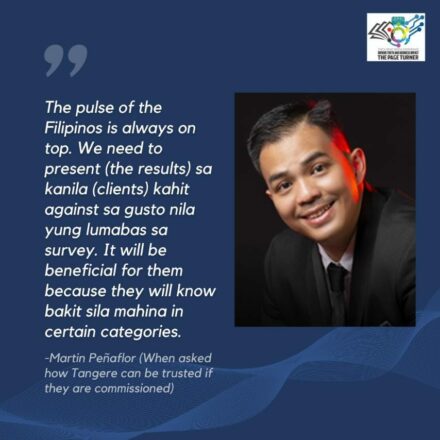
Dr. Guido David, a fellow of OCTA Research, highlights the importance of accuracy in surveys, emphasizing that clients rely on these tools to obtain reliable data for informed decision-making. “It doesn’t help them to see false data,” he stated, stressing that the purpose of surveys is to provide truthful insights that guide effective strategies. Inaccurate data undermines this goal, leading to misguided actions and wasted opportunities.

Martin Peñaflor, Founder and CEO of Tangere, emphasizes the importance of presenting honest survey results to clients, even when the findings may not align with their expectations. “The pulse of the Filipinos is always on top,” he stated, highlighting the priority of reflecting public sentiment accurately. Sharing results, even unfavorable ones, provides clients with valuable insights into their weaknesses, enabling them to address gaps and improve in key areas.

Aileen Perez, Assistant Vice President and Deputy Head of Integrated News Social Media at GMA Network, emphasizes the crucial role of the younger generation in shaping the future of the newsroom. As digital natives, they are more comfortable with evolving technologies, which can often lead to innovative ways of engaging audiences. However, it is essential for seasoned journalists to mentor and instill the values of traditional journalism—integrity, accuracy, and responsible reporting—into the next generation.
The challenge lies in balancing the rapid advancements in technology with the timeless principles of journalism. By embracing new tools while maintaining a strong ethical foundation, we can ensure a future where technology and journalistic integrity go hand in hand.

During his insightful talk, Driving Truth and Business Impact, Robby Aligada highlighted three essential pillars for building trust in branding: consistency, authenticity, and transparency.
Consistency ensures your brand delivers on its promises across all touchpoints. Authenticity allows your brand to stay true to its values and connect genuinely with its audience. Transparency fosters open communication, building credibility and long-term loyalty.
These principles are not just buzzwords—they are the driving forces behind impactful and enduring brands. Let’s strive to incorporate them into our branding strategies and create lasting impressions.

This statement serves as a testament to the enduring legacy of print journalism and its critical role in shaping media professionals, even in the fast-paced and visually driven world of broadcast news. Hizon’s remarks also reflect a sense of gratitude and mutual respect for the interdependence between different branches of journalism, emphasizing that the quality of reporting transcends mediums. His insights resonate as a reminder that the principles of effective storytelling remain timeless, regardless of the platform.

Ang’s perspective aligns with Bill Gates’ 1996 declaration that “content is king,” emphasizing that while formats evolve, the human appetite for compelling narratives and credible information persists. This insight is particularly crucial for journalists, content creators, and communicators today. It reminds us that, even in an era of short attention spans and algorithm-driven content, there remains a significant audience seeking stories that educate, inspire, and provoke thought.
